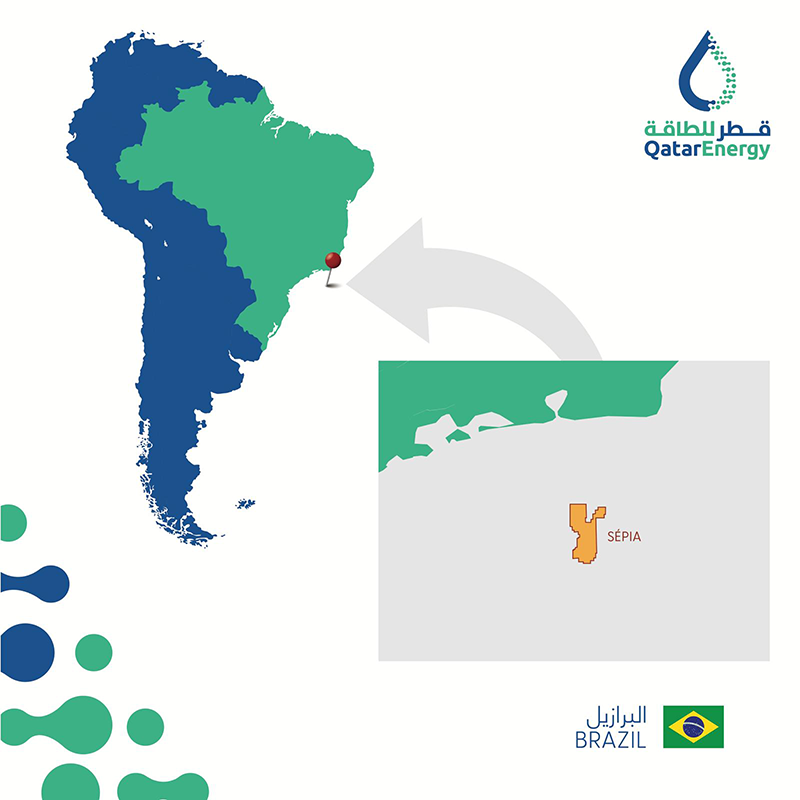QatarEnergy Takes Final Investment Decision in Phase II of Sépia Field
The floating production, storage, and offloading (FPSO) unit that will operate in the Sépia field will reduce emission intensity by 30%.
Joint partners QatarEnergy, TotalEnergies, Petronas, Petrogal Brazil, and the operator Petrobras, took the final investment decision (FID) in the second development phase of the Sépia field located off the coast of Brazil in the pre-salt Santos Basin. The contract signed with Seatrium O&G Americas Ltd. is to construct an FPSO unit to operate in the Sépia field’s deep waters and have a crude oil production capacity of 225,000 oil barrels per day, and a gas-processing capacity of 10 million cubic meters per day.
Seatrium’s FPSO is slated to reduce greenhouse gas (GHG) emission intensity by 30% per barrel of oil equivalent. GHG emission intensity will be reduced by the FPSO’s all-electric configuration and processing plant optimizations to increase energy efficiency. The unit also includes multiple environmental technologies, such as:
- Recovery of ventilated gases from cargo tanks and processing (zero routine ventilation)
- Deep seawater capture
- Speed variators in pumps and compressors
- Cogeneration with a waste heat recovery unit
- Routine zero burning (torch gas recovery/closed flare)
- Valves with requirements for low fugitive emissions
- The use and geological storage of CO2 from gas production
The FPSO will be built in shipyards in Brazil, China, and Singapore, and it will be the second FPSO to operate in the Sépia field alongside the Carioca FPSO. This unit is targeted to operate in the northern section of the Sépia field.
Location of the Sepia field offshore Brazil; Image Credits: QatarEnergy

Earlier this month, QatarEnergy signed a joint venture agreement with ExxonMobil to purchase a 40% participating interest in two offshore exploration blocks near Egypt. The 40% interest acquisition applies to the Cairo and Masry offshore concession agreements, and the operator, ExxonMobil, will maintain a 60% working interest. These offshore exploration blocks were awarded to ExxonMobil in January 2023, spanning an approximate area of 11,400 square km in depths of 2,000 to 3,000 meters.
“We look forward to working with our valued long-term strategic partner ExxonMobil, as well as with the Egyptian Natural Gas Holding Company (EGAS) and the Egyptian Ministry of Petroleum and Mineral Resources, in this promising and prospective region,” said Saad Sherida Al-Kaabi, CEO of QatarEnergy. “I would like to take this opportunity to thank the Egyptian authorities and our partners for their valuable support and cooperation.”
QatarEnergy also announced that work is underway at a new LNG expansion project, North Field West, to increase Qatar’s LNG production capacity to 142 MTPA before the end of 2030. This production increase is approximately 85% higher than current Qatari production levels. Saad Sherida Al-Kaabi, President and CEO of QatarEnergy, announced during a press conference at QatarEnergy’s headquarters in Doha.
Al-Kaabi announced that extensive appraisal drilling and testing have confirmed productive layers of Qatar’s North Field extend towards the west, which allows for the development of a new LNG production project in Ras Laffan. The CEO also announced the presence of large additional gas quantities in the North Field estimated at 240 trillion cubic feet, which raises Qatar’s gas reserves from 1,760 to more than 2,000 trillion cubic feet. Condensate reserves were also raised from 70 to more than 80 billion barrels, in addition to quantities of liquefied petroleum gas, ethane, and helium.